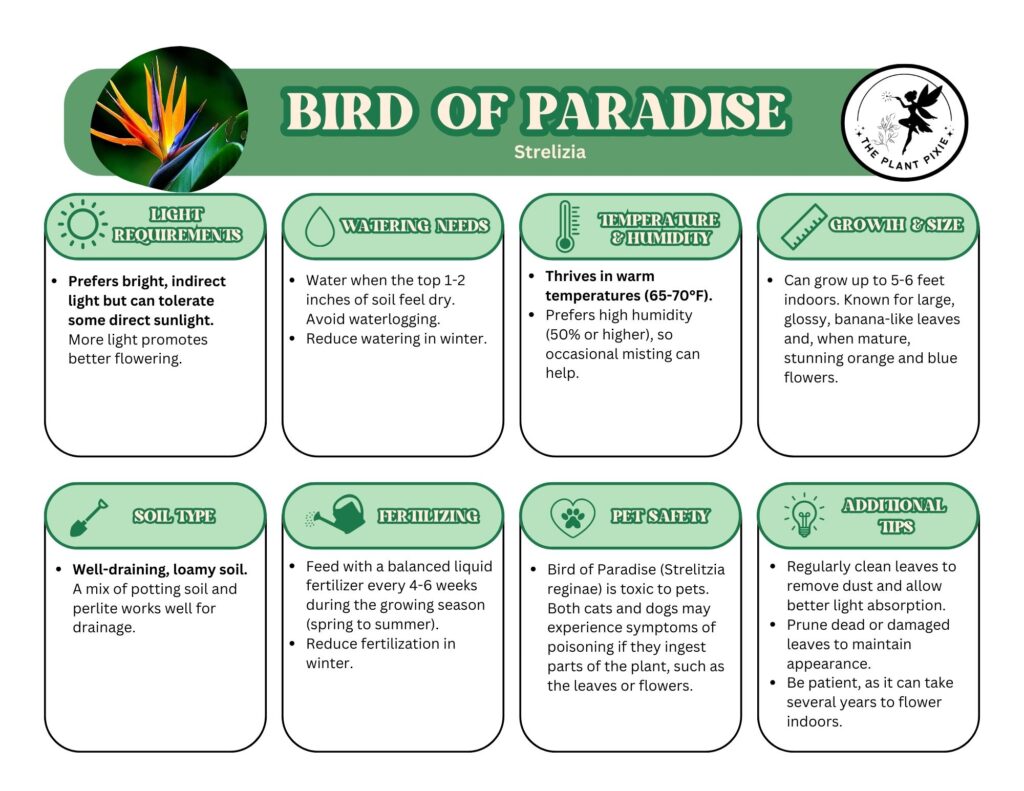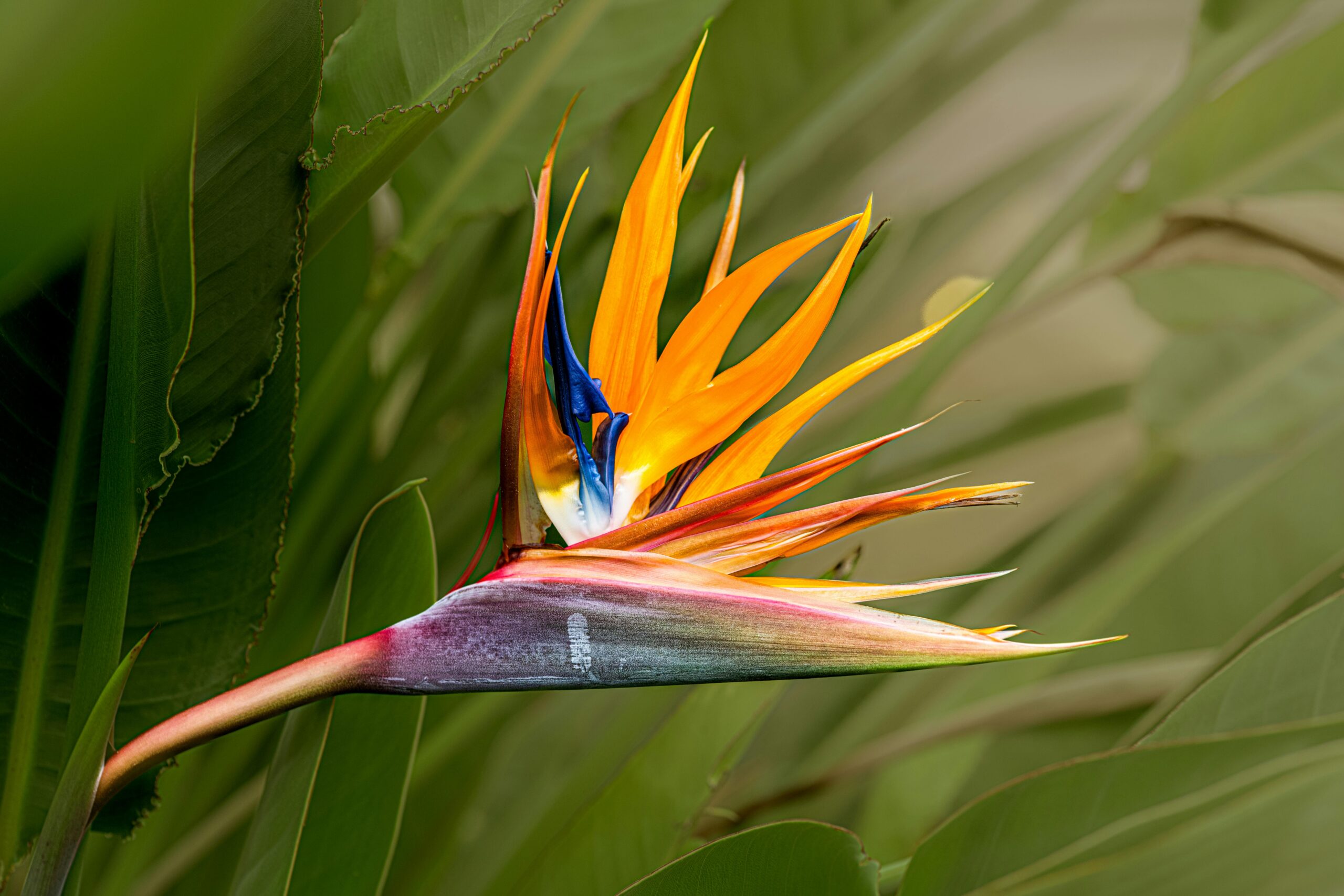
1. Botanical Overview:
- Family and Species:
- Belongs to the family Strelitziaceae, with Strelitzia reginae being the most common houseplant variety.
- Strelitzia nicolai (Giant Bird of Paradise) is a larger, more robust variety, often seen in outdoor tropical landscapes but can also be grown indoors with the right conditions.
- Plant Characteristics:
- Large, glossy, paddle-shaped leaves that resemble banana plant foliage.
- Unique, exotic flowers resembling a bird’s head, with striking colors (orange and blue for reginae, white and blue for nicolai).
- Slow-growing, but once mature, Strelitzia plants can reach significant heights (up to 5 feet for indoor plants).
2. Ideal Growing Conditions for Strelitzia:
- Light:
- Prefers bright, indirect light but can tolerate some direct sunlight, especially in the morning or late afternoon.
- Too little light can cause slow growth and fewer flowers.
- Placement: Best near east or west-facing windows for optimal light exposure.
- Temperature:
- Strelitzia thrives in warm conditions, ideally between 65°F–70°F (18°C–21°C).
- Avoid placing it in cold drafts or in rooms where temperatures drop below 50°F (10°C) as this can stunt its growth or harm the plant.
- Humidity:
- Prefers moderate to high humidity (around 50% or higher).
- Can tolerate average indoor humidity but will benefit from occasional misting or proximity to a humidifier in dry environments.
- Soil:
- Requires well-draining, slightly acidic to neutral soil (pH 5.5–7.5).
- A high-quality, well-draining potting mix for tropical plants or palms is ideal.
- Avoid heavy or compacted soils that retain too much water and can lead to root rot.
3. Watering Strelitzia:
- Watering Basics:
- Water when the top 2 inches of soil feel dry to the touch. Overwatering can lead to root rot, so allow the soil to dry out a bit between waterings.
- Water thoroughly, allowing excess water to drain from the bottom of the pot. Never leave the plant sitting in water.
- Signs of Overwatering:
- Yellowing leaves, wilting, or mushy, blackened roots.
- Foul smell from the soil, indicating root rot.
- Signs of Underwatering:
- Dry, crispy leaf edges or tips, particularly at the bottom of the plant.
- Wilting or slow growth.
- Watering Tips:
- Use room-temperature water and avoid using tap water with high mineral content, which can accumulate in the soil over time.
- In winter, reduce watering frequency as the plant’s growth slows down.
4. Fertilizing Strelitzia:
- When to Fertilize:
- Fertilize during the growing season (spring and summer) every 4-6 weeks.
- Reduce fertilization during the fall and winter when the plant is not actively growing.
- Type of Fertilizer:
- Use a balanced, water-soluble fertilizer, or one formulated for flowering plants or tropical plants.
- A fertilizer with a ratio like 10-10-10 or 20-20-20 is ideal. You can also use a slow-release fertilizer.
- How to Fertilize:
- Dilute the fertilizer to about half strength to avoid fertilizer burn.
- Apply directly to the soil, not to the leaves.
- Signs of Over-Fertilizing:
- Brown or scorched leaf tips, especially at the edges.
- Excessive growth with weak stems or yellowing foliage.
- Signs of Under-Fertilizing:
- Stunted growth or pale leaves. Lack of flowers or blooms can indicate a nutrient deficiency.
5. Common Issues and How to Solve Them:
- Yellowing Leaves:
- Causes: Overwatering, nutrient deficiencies, or poor lighting conditions.
- Solutions: Check watering routine, improve light conditions, and consider fertilizing with a balanced formula.
- Brown or Dry Leaf Tips:
- Causes: Underwatering, dry air, or low humidity.
- Solutions: Increase humidity, water the plant more frequently, and mist regularly during dry spells.
- Flowering Problems:
- Causes: Insufficient light, immature plant, or stress from poor growing conditions.
- Solutions: Ensure adequate light exposure, patience (plants may take a few years to bloom), and avoid any sudden changes in temperature or moisture levels.
- Pests:
- Common pests: Mealybugs, spider mites, scale, and aphids.
- Solutions: Regularly inspect the plant for pests, treat with insecticidal soap or neem oil, or gently wipe the leaves with a damp cloth.
6. Pruning and Maintenance:
- Why Prune Strelitzia?
- Pruning helps to maintain the plant’s shape and remove damaged or yellowing leaves.
- Encourages better airflow and prevents pest buildup.
- When to Prune:
- Prune at the end of the growing season (fall) or as needed to remove dead or damaged leaves.
- Remove any spent flower stalks to encourage new growth.
- How to Prune:
- Use sharp, clean scissors to cut off dead or yellowing leaves at the base.
- Avoid cutting healthy leaves unless absolutely necessary, as they provide essential nutrients to the plant.
7. Repotting Strelitzia:
- When to Repot:
- Repot every 1-2 years, or when the plant has outgrown its current pot (roots become root-bound).
- Repot in early spring or during the growing season to minimize stress.
- Best Potting Tips:
- Choose a pot that is 1-2 inches larger in diameter than the current pot, with good drainage holes.
- Use a well-draining, tropical plant mix or make your own mix with equal parts of peat, perlite, and pine bark.
- Repotting Steps:
- Gently remove the plant from the pot, being careful not to damage the roots.
- Trim any roots that are rotting or circling the pot, and place the plant in the new pot with fresh soil.
- Water lightly after repotting to help the plant settle in.
8. Propagation of Strelitzia:
- How to Propagate:
- Strelitzia is typically propagated through division, taking care to split the plant into smaller sections, each with its own roots.
- Propagation can also be attempted from seeds, but this method can be slow and less successful.
- Propagation Tips:
- Propagate in spring or early summer for optimal growth.
- Ensure the new division has enough roots to survive, and water well after repotting.
- Speed of Propagation:
- Divisions can take a year or more to establish themselves as healthy plants, and flowering may take several years.
- Seed propagation can take even longer, often taking several years before blooms appear.
9. Benefits of Owning Strelitzia:
- Exotic and Striking Appearance:
- The bold, architectural shape and bird-like flowers make it a stunning focal point in any room.
- Low Maintenance for a Tropical Plant:
- While it requires specific conditions, Strelitzia is relatively low maintenance compared to other tropical plants.
- Air Purification:
- Like many houseplants, Strelitzia helps purify the air by removing toxins and increasing humidity.
10. Fun Facts About Strelitzia:
- Name Origin: The genus Strelitzia is named after Queen Charlotte of Mecklenburg-Strelitz, wife of King George III of England.
- Flower Appearance: The flower of Strelitzia reginae resembles a bird of paradise, with orange “petals” and a blue “beak,” making it one of the most recognizable flowers in the world.
- Symbolism: The Bird of Paradise flower is often associated with joy, freedom, and paradise, making it a popular gift for celebrations.
- Slow Grower: While beautiful, Strelitzia is a slow-growing plant and may take several years to bloom, especially when grown indoors.

